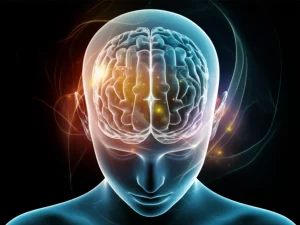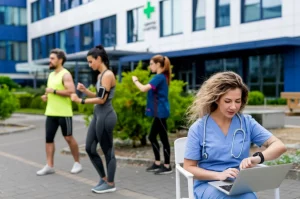Brain Waves on the Go: My Deep Dive into Our New Wearable fNIRS Gizmo!
Hey everyone! Let me tell you, the world of mental health is crying out for a bit of a shake-up. We’re talking about something that affects, like, one in three of us at some point in our lives. That’s huge! But here’s the kicker: more than half of those folks might not be getting the care they truly need. Why? Well, diagnosing and treating mental health conditions can be super tricky.
For ages, psychiatry has leaned heavily on chats – structured interviews, how patients say they’re feeling, that sort of thing. Think the DSM-5. It’s good for putting symptoms into boxes, but it doesn’t really tell us what’s going on under the hood, biologically speaking. Plus, everyone’s so different! What works for one person might not for another, and these one-size-fits-all approaches? They’re just not cutting it anymore.
The Dawn of “Precision Mental Health”
So, what’s the answer? Well, there’s this awesome movement towards “precision mental health.” It’s all about tailoring diagnoses and treatments to you, based on your unique makeup, especially your brain’s wiring and firing. Imagine getting a treatment plan that’s as individual as your fingerprint! This isn’t just about feeling better; it’s about understanding the biological roots of mental disorders to make smarter clinical decisions. It’s a big step up from just relying on self-reports, aiming for truly personalized care.
Now, you might be thinking, “Don’t we have brain scanners for this?” And you’d be right! Functional Magnetic Resonance Imaging (fMRI) has been a game-changer for understanding the brain. But, let’s be real, fMRI machines are massive, expensive, and you’re not exactly going to pop one in your living room. Plus, a lot of fMRI research looks at group averages, which can totally miss the unique brain patterns that make each of us, well, us! To really get a handle on individual differences, especially with something as complex as mental illness, we need to measure brain activity reliably and specifically, over and over again.
Getting enough data from one person with fMRI to see these individual patterns – what we call “dense-sampled data” – is a tough ask because of the cost and hassle. But it’s so important for reliable diagnosis.
Enter fNIRS: Brain Imaging That Can Keep Up!
This is where something called functional Near-Infrared Spectroscopy, or fNIRS, struts onto the stage. Think of it as fMRI’s cool, portable, and much more affordable cousin. It uses light to measure brain activity, and guess what? You can wear it! This means we can study brain function in more natural settings, not just a sterile lab. Studies have even shown that fNIRS and fMRI often tell a similar story, which is super reassuring. Plus, it’s more tolerant to movement than other portable methods like EEG, making it great for studying diverse groups, including those who might find it hard to stay still.
But, even fNIRS has had its teething problems. Many systems are still a bit clunky, wired, and need a tech whiz to operate them. Not exactly ideal for chilling at home and getting your brain mapped.

Our Brainy Baby: A Wearable fNIRS Platform for the Real World
So, what did we do? We rolled up our sleeves and developed our very own multichannel fNIRS imaging system! It’s an upgrade from our earlier single-channel device and is designed to be super easy and comfy to use, even at home. The goal? To collect loads of data from the prefrontal cortex (PFC) – that’s the brain’s command center for thinking and decision-making.
This isn’t just a piece of hardware; it’s a whole platform. Here’s the lowdown:
- A Snazzy Headband: It’s wireless, portable, and has 17 channels (that means 17 spots where it measures brain activity). It’s custom-built with five sources emitting near-infrared light (at 740 and 850 nm) and twelve detectors. This gives us 17 regular channels (source-detector separation: 2.8 cm) and 8 short channels (0.9 cm separation) covering that all-important prefrontal cortex. Why the PFC? Because it’s heavily involved in executive functions that are often impacted in mental illnesses.
- AR to the Rescue: We’ve got an intuitive tablet app that uses augmented reality (AR) – think Pokémon Go but for your brain! It guides you to place the headband perfectly every time, using the tablet’s camera. This is key for getting consistent, reproducible data, especially if you’re doing it yourself. (Full disclosure: the AR feature was developed after we collected data for this particular study, so for this round, we did manual placement using the standard 10-20 system, but it’s ready for future adventures!)
- Brain Games on a Tablet: The app also has a bunch of cognitive tests, all synced up to record your brain activity and how you’re doing on the tests.
- Cloud Power: All that precious data gets zipped off securely to a HIPAA-compliant cloud. This means clinicians can check in on brain responses and cognitive performance remotely through a user-friendly web portal.
Basically, we’ve created a way to do dense-sampling of brain activity in everyday settings – at home, school, or the office. This is a big deal for precision mental health because it gives us a more accurate picture of brain function during daily life.
Putting It to the Test: Our Proof-of-Concept Study
Alright, so we built this cool thing, but does it actually work? To find out, we ran a proof-of-concept study. We got eight awesome healthy young adults (5 females, 3 males, average age about 26) to participate. Each person completed ten measurement sessions over three weeks. Each session took about 45 minutes and included getting the device set up (self-guided!), understanding the tasks, a bit of practice, and then the actual cognitive testing.
What kind of brain workouts did they do? We had them tackle:
- N-back task: A classic working memory challenge.
- Flanker task: Tests attention and your ability to ignore distractions.
- Go/No-go task: Measures response inhibition – your brain’s braking system.
They also had resting-state measurements, just chilling with their eyes closed for seven minutes. Each test lasted seven minutes, and they got to practice beforehand. And they did great! Their accuracy on the tasks was consistently high (around 88-92%).
We collected a ton of data: 70 minutes of resting-state fNIRS data and 210 minutes of task-based fNIRS data for each person! Our main question was: can we get reliable and specific patterns of brain activity and connectivity for each individual, and do these patterns hold up over time?

The Big Reveal: Reliability Rocks with More Data!
So, what did we find? Let’s talk reliability. When we looked at data from just one session (7 minutes), the test-retest reliability for functional connectivity (how different brain areas talk to each other) was, frankly, a bit low – sometimes as low as 0.25. But here’s the magic: when we started adding data from more sessions (up to 49 minutes), the reliability shot up dramatically, reaching as high as 0.92! This was true for both resting-state (RSFC) and task-based functional connectivity (TBFC).
This is super important. It tells us that if you want to really nail down an individual’s brain connectivity patterns, you need that dense-sampled data. More is definitely more here!
You Do You: Spotting Individual Brain Signatures
Next up, we wanted to see if we could tell people apart just by looking at their brain connectivity maps. And guess what? We could! For all the tasks, the similarity of connectivity patterns was much higher within the same person across different sessions than it was between different people. It’s like everyone has their own unique brain connectivity “fingerprint.” This is exactly what we need for precision mental health – tools that can capture what makes each brain unique.
When we looked at group-level connectivity (averaging across everyone), we saw some consistent patterns. For example, there was significant positive connectivity between certain channel pairs, like those linking the right and left dorsolateral PFC (important for planning and working memory) and areas in the frontopolar cortex and orbitofrontal cortex. These generally involved interactions between the left and right sides of the prefrontal cortex. This makes sense, as we know these areas are busy during cognitive tasks.
However, we didn’t see super strong differences in connectivity patterns *between* the different tasks once we corrected for multiple comparisons. This might be because resting-state connectivity often looks a lot like task-based connectivity – our brains have these intrinsic networks that are pretty stable. Our dense sampling might have actually reinforced these stable patterns, making it harder to see subtle task-specific changes with our current sample size.

Group Averages vs. The Individual Sparkle
Now, let’s talk about brain activation during tasks. When we looked at group-average brain activity from just the first session, we didn’t see much in the way of statistically robust responses. It was all a bit fuzzy. But, when we concatenated (stitched together) data from all ten sessions, BAM! Clear, statistically significant, and spatially specific activation patterns emerged at the group level. For example:
- N-back: Activation in the left orbitofrontal cortex.
- Flanker: Activation in the right dorsolateral PFC and left orbitofrontal cortex.
- Go/No-go: Activation in the right orbitofrontal cortex and left lateral frontopolar cortex.
This again shows the power of more data! But here’s where it gets really interesting. When we looked at individual activation maps, we saw significant task-related activity in specific prefrontal regions for each person, and these were often different from the group average. In fact, there was a 67% discrepancy rate! Only one participant showed the same significant spatial feature as the group average. This is huge! It means that group averages can actually hide what’s really going on in individual brains.
To check reproducibility of these activation patterns, we used something called the Intraclass Correlation Coefficient (ICC). When we looked at single sessions, only a few channels showed good ICC. But when we averaged five interleaved sessions, about half the channels showed good (ICC > 0.6) or even excellent reliability! For instance, during the N-back task, the right and left orbitofrontal cortex showed excellent ICC. This reinforces that multiple sessions are key for reliable individual brain mapping.
Why This Matters for Mental Health Care
Okay, so we’ve got this wearable fNIRS platform that can reliably capture individualized brain patterns with enough data. What’s the big deal?
- Better Biomarkers: Dense-sampled data could help us find reliable neurobiological markers to go alongside subjective reports in diagnosing mental health conditions.
- Big Studies, Big Insights: Because our platform is relatively low-cost and portable, it opens the door for large-scale studies. This could help us understand the huge variety within mental illnesses and maybe even discover new subtypes, leading to more personalized treatments.
- Real-World Brains: Collecting data in natural settings, like at home, gives us a much truer picture of brain activity than we can get in a lab. This “ecological validity” is crucial.
- Tracking Treatment: This platform could be a sensitive way to monitor how people are responding to treatments in clinical trials, all from the comfort of their home.
Essentially, we’re moving away from small lab studies to potentially massive, real-world neuroimaging projects. This could totally change how we diagnose, monitor, and treat mental health issues.

The Nitty-Gritty: How We Did It (A Peek Under the Hood)
For those who love the details, here’s a bit more on our methods. We started with eleven healthy adults, but three didn’t complete all ten sessions, so our final analysis was on eight participants. Everyone gave informed consent, and the study was ethically approved.
Data Collection: Participants did ten sessions, at least a day apart. They sat quietly at home or their office. The whole 45-minute session was self-guided. The tasks (N-back, Flanker, Go/No-go, resting state) were always in the same order, each lasting 7 minutes with short rests in between. Before the real deal, they practiced each task with feedback. We collected both behavioral data (accuracy, response times) and fNIRS data.
Data Processing – Cleaning Up the Signals: This is where the magic happens to turn raw light signals into meaningful brain activity. We used the Brain AnalyzIR toolbox in MATLAB.
- Quality Control: We first chucked out any low-quality channels (Signal to Noise Ratio < 20 dB or Quality Index < 0.5). On average, we kept about 13 out of 17 channels per session.
- Corrections Galore: We applied baseline corrections for DC shifts and concatenation shifts. We also regressed out the global signal (average across all channels) to deal with systemic physiological noise and isolate localized brain activity.
- Motion Be Gone: Motion artifacts are a pain for any brain imaging. We used wavelet filtering (sym8, for the geeks) to find and correct these. Anything deviating by more than 5 standard deviations was zapped. We also used high-pass filtering (0.01 Hz cutoff).
- Getting to Hemoglobin: Finally, we used the modified Beer-Lambert law to calculate changes in oxygenated hemoglobin (Oxy-Hb) and deoxygenated hemoglobin (deoxy-Hb). We focused on Oxy-Hb because it tends to correlate better with fMRI BOLD signals. An age-dependent Differential Pathlength Factor (DPF) was used for accuracy.
Functional Connectivity: We used an autoregressive partial correlation measure to see how channels were talking to each other. For group-level analysis, we converted correlation coefficients to Fisher’s Z-scores and ran t-tests.
Activation Analysis: We used a general linear mixed regression model (AR-IRLS via BrainAnalyzIR) to look at brain activation, using data from short channels to help reduce noise. We applied a False Discovery Rate (FDR) correction to avoid false positives when identifying significant channels.

Bumps in the Road and The Path Ahead
No study is perfect, and ours is an initial step. The small sample size (just eight people) means we need to be cautious about generalizing. Also, our group wasn’t very diverse (e.g., no Black participants), so future studies absolutely need more inclusive cohorts. We know from other research that to find really solid brain-behavior links, you need much larger samples.
While we got informal feedback that the device was comfy, we didn’t formally assess comfort this time around. That’s definitely on the list for next time, using standardized questionnaires to make sure it’s user-friendly for long-term use.
Collecting data in natural settings is awesome for ecological validity, but it also brings challenges – think varying environments and activities. We need robust protocols for data collection (maybe even self-reports or data from smartwatches) and clever analysis techniques (like machine learning) to handle these real-world curveballs.
And remember that AR-guided placement? We didn’t use it in this study because it was finalized afterwards, but we’re excited to test it out in future work to make self-administration even smoother.
Looking forward, we’re keen to:
- Expand cortical coverage (look at more brain areas).
- Bring in behavioral measures more directly.
- Compare our fNIRS data directly with fMRI data using the same tasks.
- Take this into clinical populations, like folks with ADHD, and see how medication or other treatments affect brain connectivity.
- Maybe even link up our platform with other wearables like smartwatches for a super comprehensive view of what’s going on.
Wrapping It Up: A Brighter Future for Brain Imaging?
So, there you have it! Our wearable fNIRS platform is showing some serious promise for pushing mental health research forward. We’ve demonstrated that it can reliably capture individualized patterns of brain connectivity and activity, especially when we collect data over multiple sessions. These patterns are reproducible and highlight just how different each person’s brain activity can be – something that gets lost in group averages.
The fact that we can gather so much brain data in natural, everyday settings is a massive leap from traditional lab-based studies. It could help us understand the incredible diversity of mental illnesses, maybe even spot new subtypes, and get closer to truly personalized treatments.
Of course, there’s more work to do – bigger, more diverse studies are a must. But we’re pretty stoked about the potential here. Being able to create reliable biomarkers for early detection and monitoring of mental illness could really change lives. It’s all about paving the way for better treatments and, ultimately, better outcomes. It’s an exciting time to be peering into the brain!

Our findings really drive home that to get accurate individual-level brain activity estimates, you need good quality, dense-sampled data. The differences we saw between individuals, even in this small group, were striking and consistent with “fingerprinting” findings from fMRI. These differences could be due to all sorts of things – actual spatial variations in brain activity, brain size, or even non-biological stuff like data quality or the environment during testing.
Source: Springer Nature







